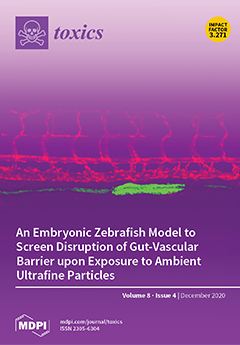Sensitive real-time detection of vapors produced by toxic industrial chemicals (TICs) represents a stringent priority nowadays. Carbon disulfide (CS
2) is such a chemical, being widely used in manufacturing synthetic textile fibers and as a solvent. CS
2 is simultaneously a very
[...] Read more.
Sensitive real-time detection of vapors produced by toxic industrial chemicals (TICs) represents a stringent priority nowadays. Carbon disulfide (CS
2) is such a chemical, being widely used in manufacturing synthetic textile fibers and as a solvent. CS
2 is simultaneously a very reactive, highly flammable, irritant, corrosive, and highly toxic compound, affecting the central nervous system, cardiovascular system, eyes, kidneys, liver, skin, and reproductive system. This study was directed towards quick detection and quantification of CS
2 in air, using time-of-flight ion mobility spectrometry (IMS); photoionization detection (PID) was also used as confirmatory technique. Results obtained indicated that IMS can detect CS
2 at trace levels in air. The ion mobility spectrometric response was in the negative ion mode and presented one product ion, at a reduced ion mobility (K
0) of 2.25 cm
2 V
−1 s
−1. Our study demonstrated that by using a portable, commercial IMS system (model Mini IMS, I.U.T. GmbH Berlin Germany) one can easily measure CS
2 at concentrations of 0.1 ppm
v (0.3 mg m
−3) in the negative ion mode, which is below the lowest threshold value of 1 ppm
v given for industrial hygiene. A limit of detection (LOD) of ca. 30 ppb
v (0.1 mg m
−3) was also estimated.
Full article






